

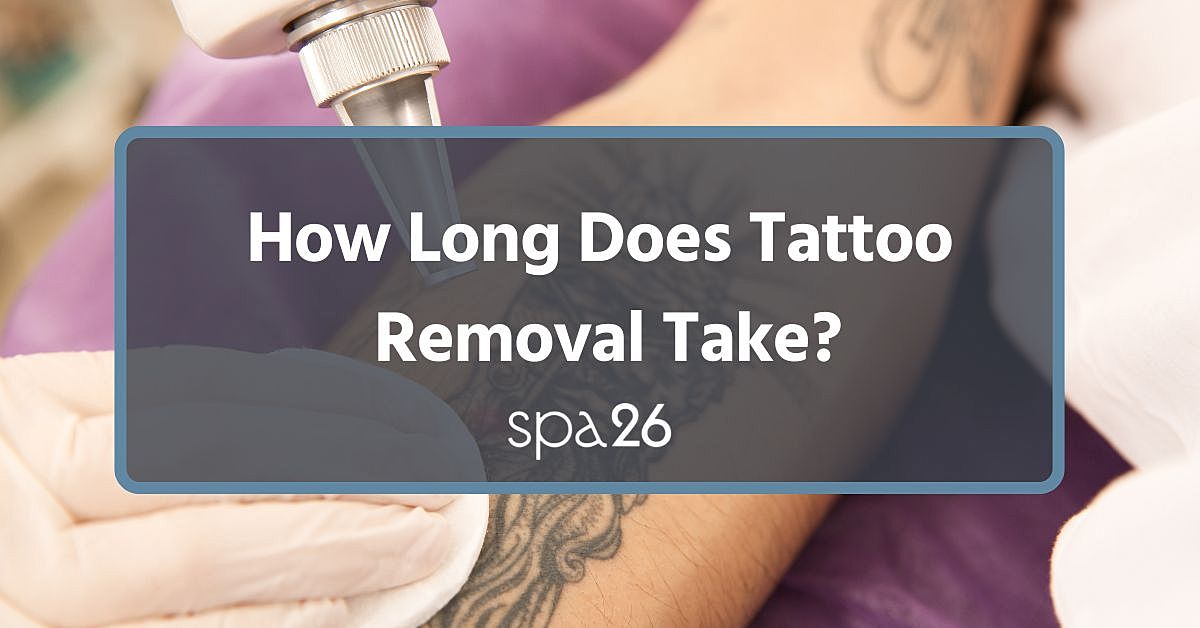 How Long Does Tattoo Removal Take?
How Long Does Tattoo Removal Take?Mar 31, 2025
Tattoos are an enduring form of self-expression, but as life changes, so can your perspective on that once-beloved ink. Whether it’s an outdated design or a faded symbol of the past, modern tattoo removal technology offers a path to clear, revitalized skin. Yet, one of the most common questions we hear is: How long does tattoo removal take?
The answer isn’t one-size-fits-all. The duration of tattoo removal varies based on factors such as the ink color, depth, size, and even your skin type. At Spa26, we combine cutting-edge technology with unparalleled expertise to ensure a safe and efficient tattoo removal experience, tailored to your unique needs.
Ready to begin your journey to clear, ink-free skin? At Spa26, we combine cutting-edge technology such as Picosure, with unparalleled expertise to ensure a safe and efficient tattoo removal experience in Beverly Hills, tailored to your unique needs. Contact us to schedule your consultation now!
In this post, we will explore types of tattoo removal treatments and factors influencing the length of the removal process. By the end, you’ll have a clear understanding of what to expect and why Spa26’s luxurious, client-focused approach is your best option for flawless results.
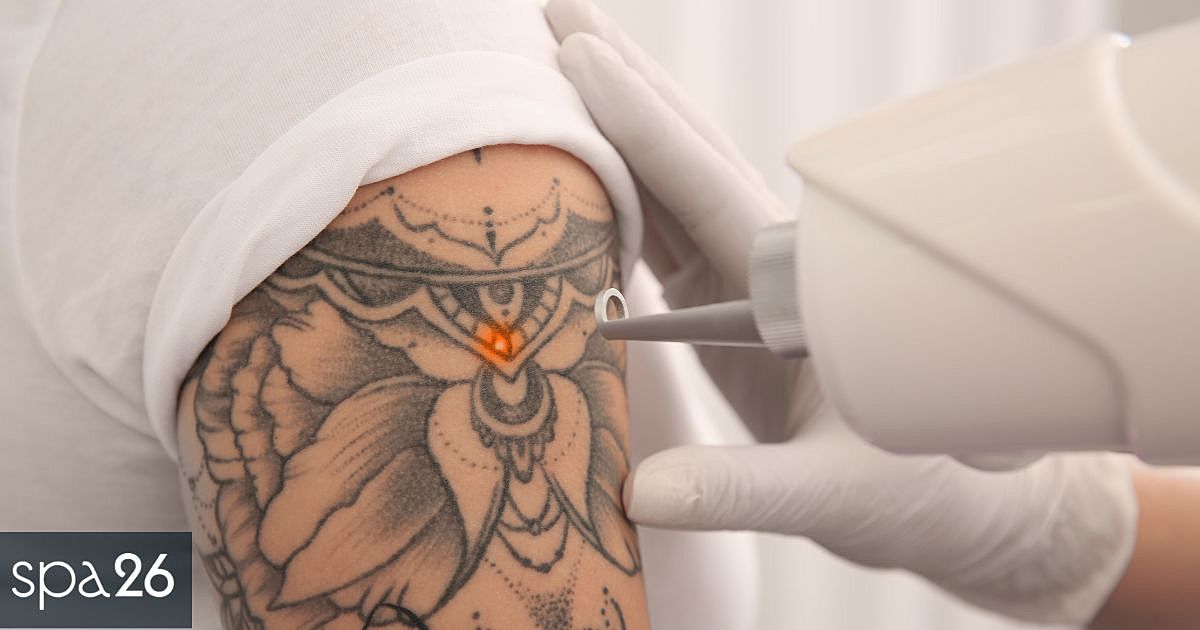
As tattoos become more common and personal expression evolves, many people find themselves reconsidering their once-beloved ink. Fortunately, advancements in technology have made it possible to safely and effectively remove tattoos with minimal discomfort and downtime.
At Spa26, we offer luxurious, state-of-the-art tattoo removal solutions designed to meet the needs of even the most discerning clients. Let’s explore the various methods available:
Laser tattoo removal is the gold standard for removing unwanted tattoos. It works by using highly focused beams of light to break down ink particles within the tattooed skin. These smaller particles are then cleared away naturally by the body’s immune system, primarily through the action of white blood cells. The process is meticulously designed to target tattoo ink without damaging the surrounding tissue, making it both safe and effective.
One of the most sophisticated and efficient laser tattoo removal systems available today is the PicoSure laser, which we proudly offer at Spa26. Unlike traditional Q-switched lasers, which deliver energy in nanoseconds and can cause burns or scarring, especially on darker skin types, PicoSure uses advanced picosecond technology to deliver energy faster than the speed of light. This rapid delivery acts like a powerful “punch,” shattering the ink particles without causing heat damage to the skin. This revolutionary approach significantly reduces the risk of scarring and allows for faster healing, making it the ideal choice for anyone seeking to remove a tattoo, regardless of skin tone.
With the PicoSure laser, most clients will need multiple sessions, spaced about six to eight weeks apart, to completely remove their tattoo. Factors such as the size of the tattoo, the colors used, and the depth of the ink will influence the number of treatments required. Generally, older tattoos and those done with darker inks respond more quickly to treatment, while newer or multicolored tattoos may take longer.
Our commitment to luxury and comfort means that pain management is prioritized during every session. Unlike other clinics that rely solely on numbing creams, Spa26 uses lidocaine injections to ensure minimal discomfort. Our approach leaves you feeling pampered and at ease, even while undergoing a complex procedure.
Surgical excision is an alternative tattoo removal method typically reserved for smaller tattoos. In this process, a surgeon physically cuts out the tattooed skin and then stitches the remaining skin back together.
While it offers the benefit of complete removal in a single session, the drawbacks include noticeable scarring and a relatively long recovery period. This method is not recommended for larger tattoos or for those concerned with maintaining a smooth, flawless appearance.
Dermabrasion involves sanding down the top layer of the skin to remove the tattoo, while chemical peels use caustic solutions to achieve a similar effect. Both methods physically strip away the tattooed skin, which can be quite painful and often results in prolonged healing times.
Due to the risk of scarring and skin discoloration, these methods have largely fallen out of favor. Compared to laser tattoo removal, they are far less effective and significantly more invasive.
Tattoo removal creams and at-home treatments promise an easy fix, but their effectiveness is extremely limited. These products typically work by lightening the top layer of skin, but they fail to break down ink particles deep within the dermis.
As a result, even after prolonged use, the tattoo remains visibly intact, albeit slightly faded. Investing in such products often leads to disappointment, as they simply cannot deliver the complete removal that professional laser treatments offer.
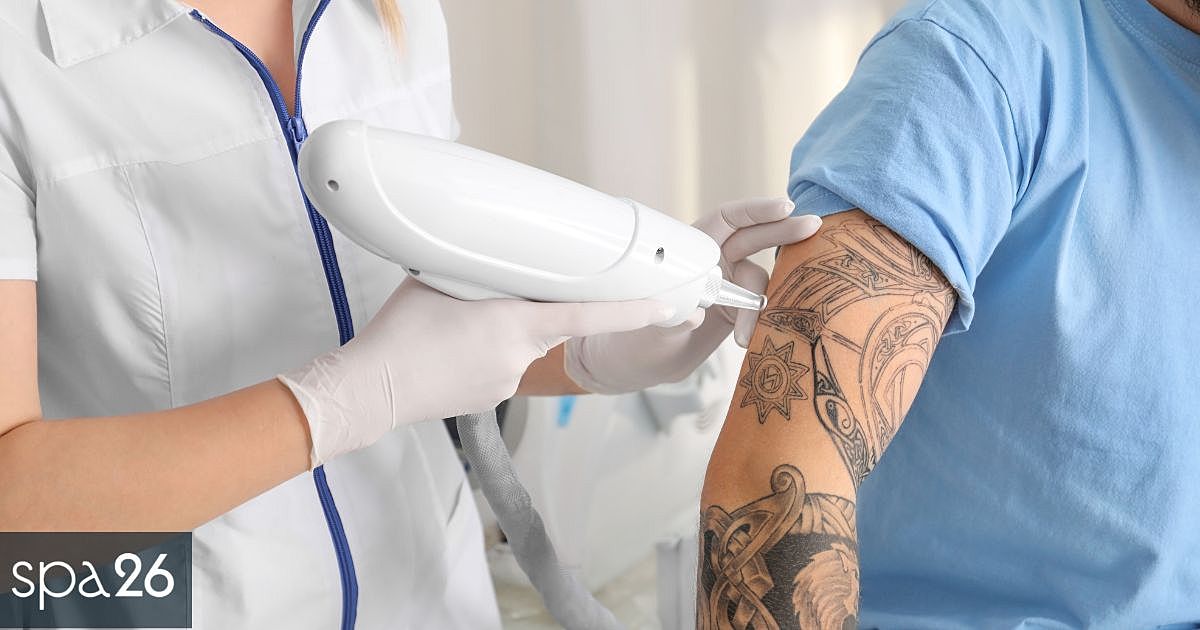
When considering tattoo removal, one of the most common questions is: How long does each session take? The answer varies depending on the method used and the size and complexity of the tattoo. At Spa26, we prioritize not only exceptional results but also a luxurious, comfortable experience that aligns with your lifestyle.
With laser tattoo removal, a single session typically takes only a few minutes, usually between 10 and 30 minutes, depending on the size and detail of the tattoo. Our PicoSure laser technology, the most advanced option available, delivers rapid pulses in picoseconds to break down ink particles without burning the surrounding skin. This cutting-edge approach ensures that each session is not only fast but also remarkably effective. Most clients find the short duration surprisingly convenient, especially when compared to older laser technologies that can take longer and involve more discomfort.
Dr. Nazarian emphasizes the importance of choosing the right technology:
“Nanosecond lasers deliver the same wavelength slowly, which can burn your skin and lead to scarring, especially on darker skin types. With PicoSure, the energy acts like a punch, exploding the ink cell without causing heat damage. Your body then naturally clears out the shattered particles over three weeks. It’s revolutionary.”
For surgical excision, the session can take about one to two hours, depending on the size of the tattoo. This method involves cutting out the tattooed skin and stitching the remaining skin together, which naturally takes more time and involves a longer recovery.
Dermabrasion sessions, where the tattooed area is mechanically abraded to remove the ink, generally take 30 to 60 minutes, while chemical peels follow a similar timeline but are far less effective and can require multiple sessions for even minimal fading. Both methods are significantly more invasive and come with extended recovery times compared to laser treatment.
Tattoo removal is not a one-and-done process. To completely remove a tattoo, multiple sessions are typically required, spaced several weeks apart. On average, clients will need around 3 to 5 sessions with PicoSure, compared to 10 or more sessions with traditional Q-switched lasers.
Between sessions, it is essential to wait about 6 to 8 weeks. This interval (laser breaks) allows your body to process and eliminate the shattered ink particles naturally while giving your skin time to heal. Rushing the process could lead to complications like skin damage or scarring, which is why our expert team carefully plans your treatment schedule to maximize safety and effectiveness.
It is also worth noting that factors like the tattoo’s age, ink colors, size, and your overall health can impact the number of sessions needed. Darker, older tattoos tend to respond more quickly, while colorful or newer tattoos may take longer to fade.
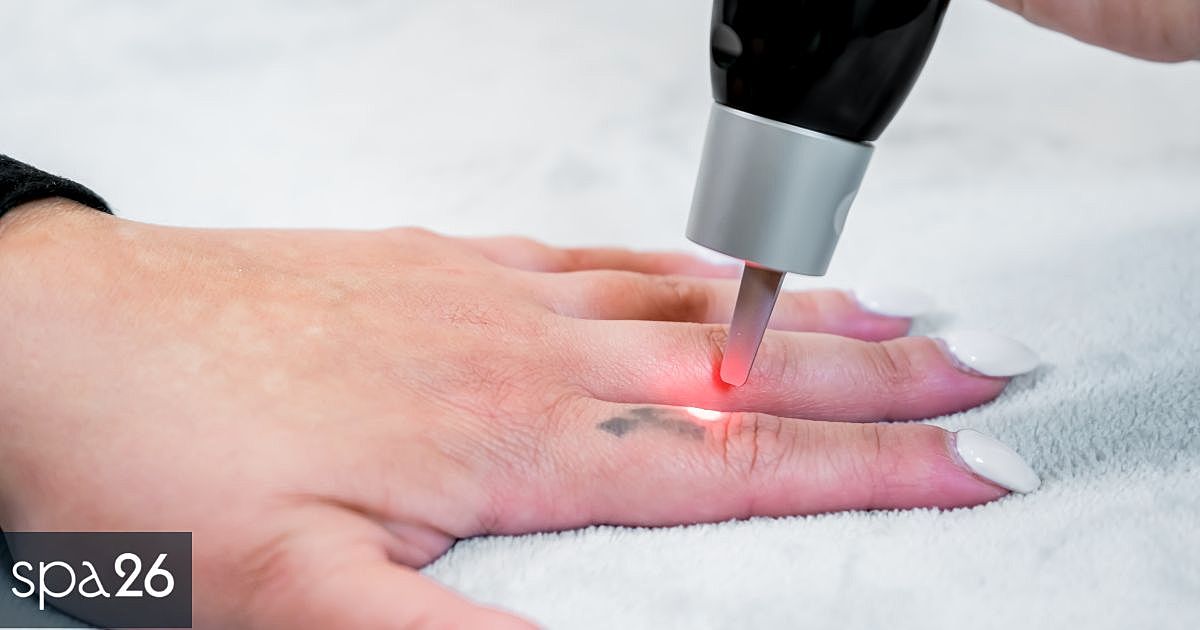
Removing a tattoo is a journey that requires both patience and commitment. While laser tattoo removal has become the most effective way to clear unwanted ink, it’s essential to understand that the speed and success of the tattoo removal process can vary significantly from person to person
Several factors influence how long it takes to completely remove a tattoo. Let’s explore these factors in detail.
One of the most significant factors affecting how long tattoo removal takes is the size of the tattoo itself. Naturally, larger tattoos take longer to treat, as the laser needs to break down more ink particles. During a single laser tattoo removal session, the laser light targets the tattooed skin and shatters the ink into smaller particles. These particles are then cleared away by the body’s immune system, primarily through the action of white blood cells.
The location of the tattoo also plays a role in determining the speed of removal. Areas of the body with better blood circulation, such as the upper arms, chest, and torso, generally heal more quickly than areas with poorer circulation, like the lower legs or feet. This improved circulation helps the body safely remove ink particles faster, resulting in fewer treatments.
Different ink colors respond differently to laser tattoo removal, impacting how many laser sessions you may need. Darker inks, like black and dark blue, are generally easier to break down with laser treatment because they absorb more laser energy. However, lighter colors such as yellow, green, and turquoise can be more challenging to remove and often require more sessions to achieve complete clearance.
Professional tattoos tend to have deeper ink placement and higher-density pigments, making them more difficult to treat compared to amateur tattoos, which are often less uniform and lighter. Additionally, multi-colored tattoos may necessitate the use of multiple laser wavelengths to target each pigment effectively.
With PicoSure laser technology, the laser delivers energy at an ultra-fast picosecond speed, shattering even stubborn and multi-colored inks more efficiently than older nanosecond lasers, which deliver energy slowly and can burn the skin. This revolutionary technology drastically reduces the number of sessions needed while minimizing the risk of skin discoloration and scarring.
The way your body responds to laser tattoo removal is heavily influenced by your skin type and overall immune system health. Individuals with darker skin tones are more prone to hyperpigmentation or hypopigmentation if the wrong laser is used. This is why Spa26 uses the PicoSure laser, which significantly lowers the risk of skin damage by delivering energy rapidly without causing burns.
Additionally, the body’s ability to break down and eliminate ink particles plays a crucial role in how fast your tattoo fades. A strong, healthy immune system will typically clear the broken-down ink faster, resulting in quicker recovery times and fewer treatments.
While laser removal is the most popular and effective method, other options like surgical excision and dermabrasion exist. Surgical excision involves cutting out the tattooed skin and stitching the area closed, which may take a few hours and leaves noticeable scars. On the other hand, dermabrasion sands down the skin to remove the tattoo, but this can be quite painful and leaves the area vulnerable to infection. Both methods have longer recovery times and are less desirable compared to the PicoSure laser tattoo removal process.
Tattoo removal is not an overnight process, as your body needs time to naturally clear away the broken-down ink particles. Typically, laser sessions are scheduled six to eight weeks apart to give your body ample time to heal. This waiting period ensures that your skin is completely healed before undergoing the next treatment, reducing the risk of complications and optimizing results.
Impatiently rushing the process can hinder your progress, as inadequate healing between sessions may lead to skin damage or scarring. At Spa26, we carefully plan your treatment plan to align with your body’s natural healing cycle, helping you achieve the final results safely and effectively.
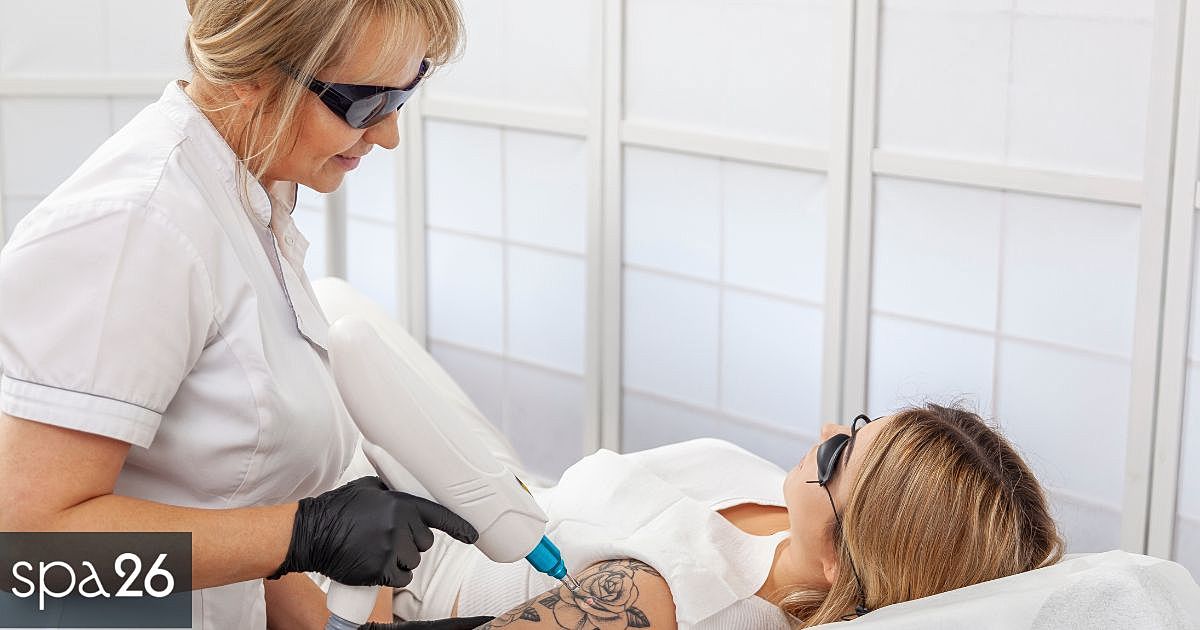
Tattoo removal can be an uncomfortable experience, but the level of pain varies significantly from person to person. Much like getting a tattoo, the sensation is often described as similar to a rubber band snapping against the skin or a quick, stinging sensation. At Spa26, we understand that pain management is a priority for our clients, and we are committed to making your tattoo removal process as comfortable as possible.
While it is natural to be concerned about discomfort during laser tattoo removal, it is essential to note that Spa26 utilizes PicoSure laser technology, a revolutionary approach that delivers focused beams of laser energy in picoseconds rather than the slower nanosecond pulses used by older lasers. This rapid energy delivery reduces the risk of burning and minimizes discomfort, allowing your body to safely remove the ink particles without causing undue pain.
The level of discomfort during laser tattoo removal is often mild to moderate, but it can vary based on factors like the size of the tattoo, its location, and individual pain tolerance. Certain areas of the body, such as the ribs, hands, and feet, are naturally more sensitive and may feel more intense during the removal process. Conversely, areas with thicker skin or more muscle mass tend to be less painful.
One of the key differences between Spa26 and other clinics is our approach to pain management. Many facilities only use numbing creams, which offer minimal relief. As Dr. Nazarian explains, relying solely on numbing cream is like “putting cream on and then dragging a cigarette on your skin.” Instead, we use lidocaine injections to thoroughly numb the treated area, significantly reducing discomfort and making the experience far more tolerable.
Other tattoo removal methods, such as dermabrasion and chemical peels, can cause a more intense, stinging sensation as they physically abrade the skin. These methods often require longer recovery times and come with a higher risk of scarring or skin damage. Surgical excision, while effective for small tattoos, also involves significant pain and leaves noticeable scars. By contrast, PicoSure laser removal at Spa26 is not only faster and more efficient but also much more comfortable.
Tattoo removal is a journey that requires patience and dedication, but with the right approach and advanced technology, it’s entirely possible to achieve remarkable results. The duration of tattoo removal depends on several factors, including the size of the tattoo, its location, the colors used, your skin type, and the removal method chosen. Typically, laser tattoo removal with PicoSure technology, offered exclusively at Spa26, delivers faster, more efficient results with fewer sessions compared to traditional methods.
Before committing to tattoo removal, it’s important to understand the time commitment and the factors that may influence the speed and success of the removal process. Consulting with a professional will give you a personalized assessment and help set realistic expectations based on your specific tattoo and skin type.
If you’re ready to reclaim your skin and say goodbye to unwanted tattoos, book your consultation today at Spa26. Our experienced specialists are here to guide you through every step, ensuring optimal results and a luxurious experience.

Sheila Nazarian is the founder and operator of Spa26. Dr. Nazarian’s Spa26 patients benefit from her numerous qualifications. She has years of training and expertise as a board-certified plastic surgeon. She graduated from Columbia University, where she concentrated in pre-med. She studied medicine and earned her doctor of medicine degree at Albert Einstein College of Medicine at Yeshiva University.

Spa26 offers luxury skincare, anti-aging treatments, and wellness services. Consult with our experienced team at (310) 683-7537.